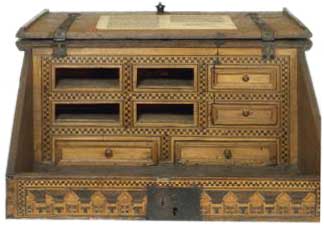Oak Wood Furniture
1500 - 1660
During the period 1500 to 1660 the main hardwood in use by furniture craftsmen was solid oak wood. Most of the oak wood used at this time was native grown in England with some being imported from the Baltic sea countries or Scandinavia. Higher end furniture tended to be made from these Baltic imports which were called "clapboard" and were of a whiter, softer, and finer grain than the local English species.
English Oak
English oak, from the Pedunculate oak (Quercus robur) tree, is known as the "king of trees" in popular folklore in England and occupies a special place in English furniture history, being considered the most "English" of woods with usage going back to the earliest of times. Solid oak wood furniture is typified by being well figured and for its hardness and durability.

Early 1600's, Oak Clothes Chest, joined and carved.
English oak is a very beautiful and very hard wood. Its colour varies from pale golden yellow to a deep golden brown, the latter tone being acquired only by age, and although it is often imitated by stains and polishes, only years and the lightest wax polishing can mellow oak. The fine figuring of the heart-wood is generally sought by craftsmen, and English oak shows a very beautiful figure when it is cut on the quarter, that is, when each board cut is directly in line with the centre of the tree.
Brown Oak
What is sometimes spoken of as brown oak is wood taken from a tree that has died before felling. The sap in such a tree rises, and remains in the wood and hardens, giving a very soft delicate shade of brown, the sort of hue light brown crayon makes on rough paper, and this brown oak, although inclined to be brittle, can be handled very pleasantly by a skilful craftsman.
The hardness of English oak and the consequent difficulties of working it have not endeared it as a material to many manufacturers, but for machine-made furniture the Austrian, American and Japanese varieties are used.
Austrian, Japanese, & American Oak
Austrian oak is much softer than English, but its figuring is not so fine, and American oak is easy to work, but its marking is rather uninteresting, being straight and very plain. Few varieties of the wood can equal the beauty of the English tree. Japanese oak is easy to work, and although very much plainer than English is more satisfactory in appearance than American oak, and its texture and colour are not unpleasing.
Old Oak
The craftsmen of the sixteenth and seventeenth centuries who used English oak exclusively were able to invest their work with an interest and an air of durability partly because the mere fact of working such a hard and beautiful material cultivated their ability as craftsmen, and time has exercised its mellowing influence so well that the words "old oak" invariably suggest fine workmanship.
New Oak
The clean, pleasant colour of new oak is sometimes forgotten by collectors who seem to think anything of value must be aged by a couple of centuries, but the fresh, clear yellows and light browns of new English oak, well seasoned, lightly polished with a little wax, can bring much beauty to furnishing.
Bog Oak
Bog oak is used largely for inlaid work, and is black in colour, the wood being found below the surface of peat bogs, where it has been immersed; but the exact age of such wood is unknown. Some pieces of furniture are made to imitate bog oak and are often thought of as very decorative, "quaint" and "charming". Furniture made entirely with such dark material, however, is extraordinarily heavy in appearance, and nobody who is familiar with the natural colour of oak can do anything but regret the fact that this charade is carried on at all.
Oak Eras
Oak wood furniture is most associated with the following eras: Tudor furniture and Elizabethan furniture, Jacobean furniture, Commonwealth and to a lesser extent the Restoration period by which time walnut was increasingly being utilised and oak became restricted to use in English country furniture and to carcase or body portions of fine and veneered furniture.
Most oak wood used during these periods was either plain sawn, that is cut parallel with the diameter of the trunk, or not quarter cut. Oak wood was normally seasoned in water for a time.
Bog oak, as mentioned wood preserved in bogs of peat and therefore of nearly black colour, was employed as an inlay along with holly, sycamore, poplar, beech, ash, yew, and fruit woods for much of the main oak wood period.

1600, Table Desk, Oak, inlaid with boxwood and bog oak; interior drawers in poplar; tinned iron hinges.
During the same period as oak's predominance elm wood was often used for tabletops, and ash and beech for chairs, while some turned chairs were made of yew.
Oak fell out of favour among fashionable circles during the last half of the seventeenth century and remained in provincial obscurity until making something of a heroic comeback in the time of early Victorian furniture, admired for its sturdy English qualities. In this time oak was used especially for furniture in a pseudo Gothic style as well as being favoured by some artisans in the Arts and Crafts furniture movement. Among antique sellers and reproductions makers oak wood furniture continues in some demand today.

1852, Gothic Revival Table in Oak
Beech wood occupies our interest in the following section.
